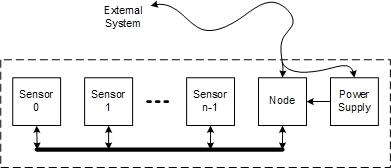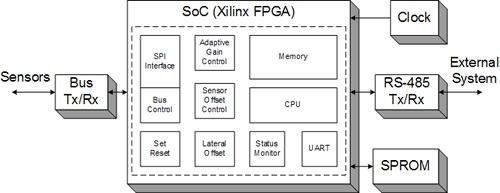
Intelligent Roadway Magnetic Reference Sensing System Enhances Outlook for Vehicle Guidance and Control
Link to pdf here.
AHMCT researchers have developed an intelligent sensing system for detecting road-embedded magnetic reference systems. The system addresses drawbacks of previous research prototypes, and moves magnet-based vehicle guidance and control closer to real- world application. The patented system works for both discrete embedded magnets and continuous magnetic references, i.e. “tape,” and can be applied in highway maintenance, transit, commercial vehicle, loading, factory, and airport operations. The design and algorithms developed in this research are patented and are available for licensing through the UC Davis Office of Technology Transfer.
Why We Pursued This Research
Discrete and continuous magnetic reference systems have been developed by PATH and 3M, and have been shown to be well-suited for lateral vehicle guidance and control in GPS-challenged environments. However, the previous sensing system implementation could not scale beyond a limited number of research prototypes. With a view towards commercialization, AHMCT researchers have developed an innovative intelligent roadway magnetic reference sensing system that addresses the shortcomings of previous implementations, and which can support magnet-based vehicle guidance and control on a large scale.
What We Have Done

Existing research prototype implementations for magnetic reference sensing are not well-suited for large-scale commercial implementation. Drawbacks include analog signal transmission leading to sensor noise and significant cabling requirements, magnet- strength dependence, high cost, and complex manufacturing and packaging issues. In addition, some aspects of the existing sensing approach have weaknesses for low-speed operations as they introduce velocity-dependence into the system. AHMCT researchers have developed a highly integrated, patented innovative sensing system and algorithms which address the deficiencies of previous implementations, leading to a system that is ready for full-scale commercial development and deployment. With this, a key component of the vehicle subsystems needed for magnet-based lateral vehicle guidance and control is now ready for wider application.

The intelligent roadway magnetic reference sensing system applies current state-of-the-art and state-of- practice technologies to provide a cost-effective and robust package suitable for deployment as a “black box” for end-user installation. The multi-axis magnetic sensors immediately digitize the analog sensor signals, which removes a significant noise source from the overall sensing system. Each individual digital magnetometer communicates digitally with a central intelligent “hub” via a high-speed data bus. The hub, which determines the relative lateral offset to discrete magnets or continuous tape using an AHMCT-patented algorithm and outputs all reference data through a serial data (RS232 or RS485) link, provides all necessary processing and communication to other in-vehicle components. The hub design leverages modern embedded processing, digital signal processing, algorithms, and communications techniques and technologies to greatly improve overall performance and address issues with the previous implementation. The hub uses embedded hardware known as a Field Programmable Gate Array (FPGA), which is well-suited for the development and supports the System-on-a- Chip (SoC) approach key to the current system. The development of this embedded FPGA SoC architecture and hardware has significantly enhanced essential core competencies and strengths at the AHMCT Research Center, as the architecture can be applied for other sensor and actuator mixes.

The intelligent roadway magnetic reference sensing system essential features and advantages are all directed towards commercialization and deployment. The system cost is, even in prototype, an order of magnitude lower than is feasible with previous implementations. System installation and maintenance is tremendously eased, as the digital data transmission allows improved physical packaging, and reduces cabling to the sensor down to a very small number of conductors, allowing a single cable to provide power and noise-free data transmission. With this, the system can be packaged as a “black box” for easy end-user installation, enhancing robustness and maintainability, and further improving the prospects for deployment in difficult vehicle-based application environments.

Additional advantages are provided by the innovative algorithms that process the magnetic signals to derive needed information such as lateral offset from lane centerline. The new methods are effectively independent of magnet strength, spacing, and ride height, as long as the fields are high enough to be detected. This provides data update rates independent of vehicle speed, supporting operation down to a standstill—important for any vehicle control application, and critical for low-speed applications, such as automated bus-docking for loading of disabled passengers. The algorithms are also independent of the magnetic reference system type—i.e. the hardware and software can flexibly support both discrete and continuous (“tape”) magnetic reference systems, providing great flexibility and choice to the infrastructure installer. Use of advanced DSP concepts, such as Adaptive Gain Control, provide the highest performance over the widest range of conditions, and allow great immunity from magnet strength variations and vehicle ride-height. The scientific principles applied for the lateral offset determination also lead to greatly reduced requirements for system calibration.
The Researches Recommended
The patented intelligent roadway magnetic reference sensing system is ready for commercial development and wide-scale deployment. It can be applied for vehicle guidance, control, and driver assistance in airport runways, industrial warehouses, cargo loading areas in shipyards, parking lots, transit bus docking, manufacturing plants, fleet maintenance yards, golf courses, amusement parks, Intelligent Transportation Systems, and roadway maintenance. Interested parties are encouraged to contact AHMCT, or the UC Davis Office of Technology Transfer, to discuss opportunities for licensing this ground-breaking technology.
For Additional Information
The patented intelligent roadway magnetic reference sensing system is ready for commercial development and wide-scale deployment. It can be applied for vehicle guidance, control, and driver assistance in airport runways, industrial warehouses, cargo loading areas in shipyards, parking lots, transit bus docking, manufacturing plants, fleet maintenance yards, golf courses, amusement parks, Intelligent Transportation Systems, and roadway maintenance. Interested parties are encouraged to contact AHMCT, or the UC Davis Office of Technology Transfer, to discuss opportunities for licensing this ground-breaking technology.
| Larry Baumeister Caltrans Project Manager |
Larry_Baumeister (at) dot.ca.gov | (916) 227-5835 |
| Ty A. Lasky Research Engineer, Primary Contact |
talasky (at) ucdavis.edu | (530) 752-6366 |
| Stephen Donecker Chief Engineer for this Invention |
smdonecker (at) ucdavis.edu | (530) 752-6179 |
| Bahram Ravani Principle Investigator |
bravani (at) ucdavis.edu | (530) 754-6130 |
This document is disseminated in the interest of information exchange. The contents do not necessarily reflect the official views or policies of the AHMCT Research Center, the University of California, the State of California, or the Federal Highway Administration. This document does not constitute a standard, specification, regulation, or imply endorsement of the conclusions or recommendations.
(rev. April 2004)
